Sigma 24-105mm f/4 DG OS HSM A Lens Review
Sigma 24-105mm f/4 DG OS HSM A Performance
At 24mm, sharpness is already outstanding in the centre of the frame at maximum aperture and approaching excellent levels of clarity towards the edges. In fact, diffraction appears to be the limiting factor on performance at this focal length, with sharpness towards the edges of the frame increasing slightly at f/5.6, otherwise there is no performance gain from stopping down.This high level of performance is maintained at 50mm, with outstanding sharpness in the centre and excellent clarity towards the edges of the frame at maximum aperture. Stopping down to between f/5.6 and f/8 results in peak performance as sharpness is outstanding across the frame.
Finally, at 105mm, there is a slight drop in performance at maximum aperture, with sharpness in the centre approaching excellent levels in the centre of the frame, and good clarity being produced towards the edges of the frame. Peak performance for this focal length is realised at f/8, where sharpness improves to outstanding levels across the frame.
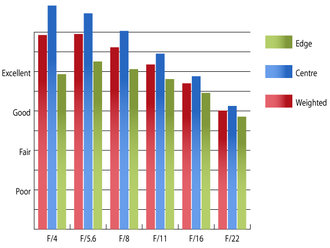 MTF@24mm | 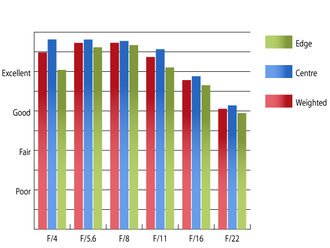 MTF@50mm |
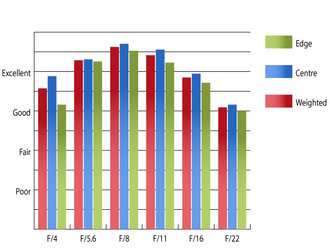 MTF@105mm | How to read our chartsThe blue column represents readings from the centre of the picture frame at the various apertures and the green is from the edges. Averaging them out gives the red weighted column.The scale on the left side is an indication of actual image resolution. The taller the column, the better the lens performance. Simple. For this review, the lens was tested on a Canon EOS Mark III using Imatest. |
Chromatic aberrations are reasonably well controlled, just exceeding 0.75 pixel widths at 105mm and f/4, as well as f/22 at 24mm. This low level of CA should pose few issues, even in large prints, or harsh crops from the edges of the frame.
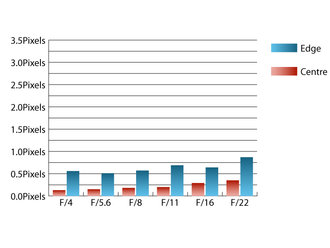 CA@24mm | 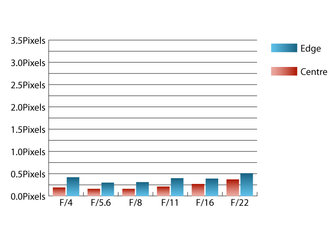 CA@50mm |
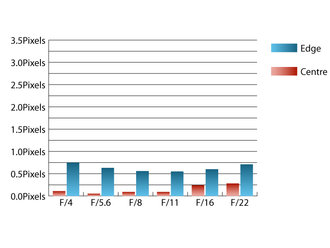 CA@105mm | How to read our chartsChromatic aberration is the lens' inability to focus on the sensor or film all colours of visible light at the same point. Severe chromatic aberration gives a noticeable fringing or a halo effect around sharp edges within the picture. It can be cured in software.Apochromatic lenses have special lens elements (aspheric, extra-low dispersion etc) to minimize the problem, hence they usually cost more. For this review, the lens was tested on a Canon EOS 5D Mark III using Imatest. |
Falloff of illumination towards the corners of the frame is fairly well controlled. At 24mm the corners are 1.9 stops darker than the image centre and at 105mm the corners are 1.7 stops darker than the centre. Visually uniform illumination isn't achieved until the lens is stopped down to f/8 or beyond throughout the zoom range.
Barrel distortion can be quite noticeable at 24mm, with 4.5% barrelling being present. This is replaced with 1.31% pincushion distortion at 105mm, which is a very mild amount of distortion. If straight lines are paramount, then you'll be glad to hear that the distortion pattern is uniform across the frame at both ends of the zoom range, which should make applying corrections in image editing software fairly straightforward.
A petal-shaped hood is supplied as standard with the lens, which does a decent job of shading the lens from extraneous light that may cause unwanted flare and loss of contrast. During testing there were no issues with flare and contrast holds up well, even when shooting into the light.
Add your message
Login required
Please login here or if you've not registered, you can register here. Registering is safe, quick and free.
Please login here or if you've not registered, you can register here. Registering is safe, quick and free.
photodo Stats
1102 lenses
428 MTF tests
74 in-depth photodo reviews
100+ users join each day
Help the lens community by reviewing or rating a lens today via our lens search
428 MTF tests
74 in-depth photodo reviews
100+ users join each day
Help the lens community by reviewing or rating a lens today via our lens search
Latest Lens Reviews
- Chinon 28mm f/2.8 Vintage Lens Review
- Canon EF 70-200mm f/4L IS II USM Lens Review
- Samyang AF 85mm f/1.4 EF Review
- Sigma 70mm f/2.8 DG Macro Art Review
- Samyang AF 24mm f/2.8 FE Review
- Meike 50mm f/1.7 Review
- Tamron 70-210mm f/4 Di VC USD Review
- Lensbaby Burnside 35mm f/2.8 Review
- Asahi Super Takumar 50mm f/1.4 Review
- Asahi Super-Multi-Coated Takumar 135mm f/3.5 Review
